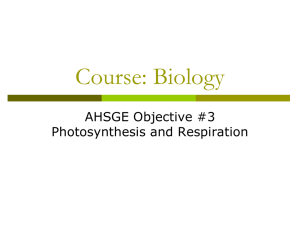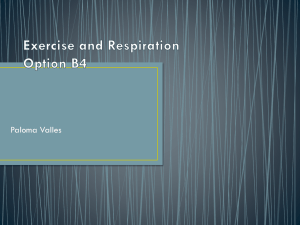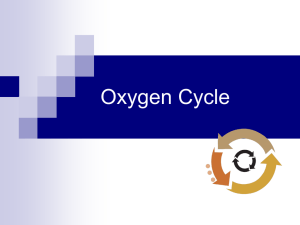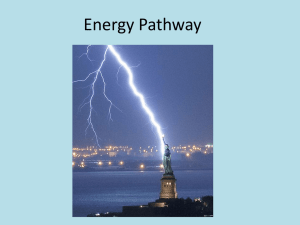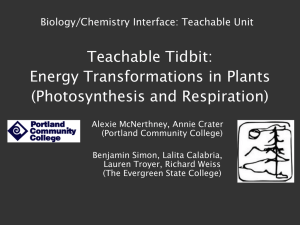60 EOC Sample Questions and Answers
advertisement
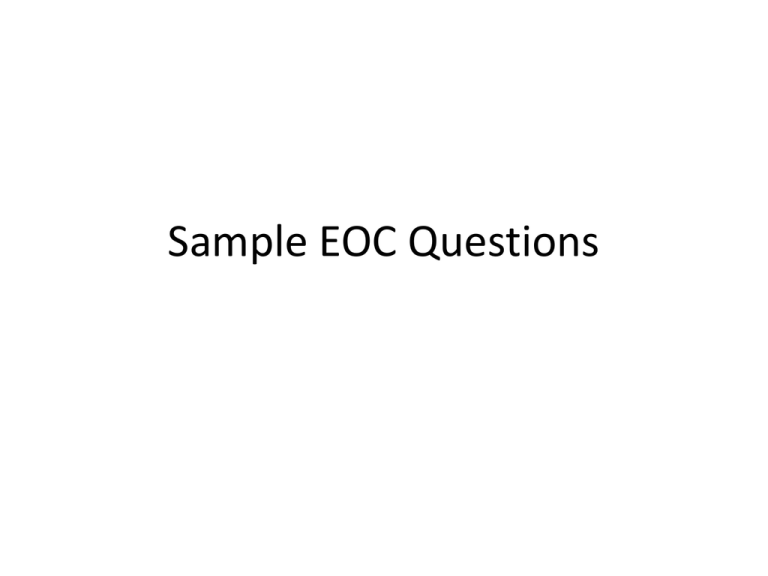
Sample EOC Questions BIOCHEMISTRY QUESTIONS Sample Biochemistry questions • 1. An iodine solution is placed on the cut side of a potato. Within seconds, a blue-black color appears. What is most likely occurring? • A a positive test for proteins • B a positive test for starches • C a negative test for proteins • D a negative test for starches Sample Biochemistry questions • 2. A sugar, a phosphate group, and a nitrogen base form the building blocks of which organic compound? • A carbohydrates • B lipids • C nucleic acids • D proteins Sample Biochemistry questions • 3. Enzymes are classified as which of the following biological organic compounds? • A carbohydrates • B lipids • C nucleic acids • D proteins Sample Biochemistry questions • 4. Individuals who lack lactase are unable to break down the sugar lactose. Which term best describes lactase? • A enzyme • B fatty acid • C lipid • D starch Sample Biochemistry questions • 5. What will most likely happen if an appropriate enzyme is added to a chemical reaction? • A The reaction rate will increase. • B The equilibrium of the reaction will be maintained. • C The reaction rate will decrease. • D The reaction will stop. Sample Biochemistry questions • 6. This diagram shows an enzyme-substrate complex. Which is represented by Structure X? • A substrate • B product • C enzyme • D complex Sample Biochemistry questions 7. Enzymes are proteins that help increase the rate of chemical reactions inside cells. These proteins are composed of many simpler molecules called amino acids. Which of the following suggests that the shape of an enzyme determines the enzyme’s function? • F Enzymes are specific to a substrate. • G Enzymes can operate in a wide range of conditions. • H Enzymes are activated by neighboring molecules. • J Enzymes can be found in all life-forms. Sample Biochemistry questions 8. Proteins and polysaccharides are polymers. These polymers are formed by dehydration synthesis. Which statement correctly identifies a difference in the structure of proteins and polysaccharides? • F Only polysaccharides are comprised of repeating units of cytosine, adenine, guanine, and thymine. • G Only proteins are formed from amino acids joined by peptide bonds. • H Only polysaccharides can be folded and twisted to very specific shapes. • J Only proteins can be large molecules with thousands of subunits. Sample Biochemistry questions 9. Which of these best represents a fatty-acid molecule? CELL QUESTIONS Sample Cell questions • 1. Which of the cells characterized in the chart below is a prokaryotic cell? • A Cell A • B Cell B • C Cell C • D Cell D Sample Cell questions • 2. A type of cell that can exist in a broad range of environmental conditions, can rapidly multiply, and lacks a nucleus is known as what type of cell? • A animal • B eukaryotic • C plant • D prokaryotic Sample Cell questions • 3. A scientist treats a cell with a chemical that destroys the ribosomes. As a result, which cell process will be stopped? • a. osmosis • b. photosynthesis • c. protein synthesis • d. respiration Sample Cell questions 4. Which is the most likely function of a group of cells that contains a high number of chloroplasts? • A respiration • B transpiration • C fermentation • D photosynthesis Sample Cell questions • 5. Which cell structure is correctly paired with its primary function? • (1) ribosome–protein synthesis • (2) mitochondrion–movement • (3) vacuole–cell division • (4) nucleus–storage of nutrients Sample Cell questions • 6. Protein synthesis occurs at which of the structures shown to the right? • AI • B II • C III • D IV Sample Cell questions • 7. This diagram represents a cell. • Which organelle is the site where amino acids are synthesized into proteins? • A. 1 • B. 2 • C. 3 • D. 4 Sample Cell questions 8. The diagram below represents a cell of a green plant. Solar energy is used to produce energy-rich compounds in structure • (1) A • (2) B • (3) C • (4) D Sample Cell questions 9. Both euglena and cyanobacteria are photosynthetic unicellular organisms found in pond water. The feature that distinguishes euglena from cyanobacteria is the — • A ability to maintain homeostasis • B presence of ribosomes • C ability to reproduce • D presence of a nuclear membrane Sample Cell questions 10. Which cellular process takes place in the ribosomes that are bound to the endoplasmic reticulum? • A The breakdown of waste material • B The conversion of radiant energy to glucose • C The synthesis of new proteins • D The replication of nucleic acids Sample Cell questions 11. Cell differentiation is critical during embryonic development. The process of cell differentiation results in the production of many types of cells, including germ, somatic, and stem cells. Cell differentiation is most directly regulated by — • A ATP • B DNA • C lipids • D sugars PHOTOSYNTHESIS & RESPIRATION QUESTIONS Question #1 • 1. The major source of the oxygen that is released into the atmosphere is • A cellular respiration • B photosynthesis • C automobile exhaust • D the weathering of rocks Question #2 • 2. Which most accurately describes the difference in ATP production between aerobic respiration and anaerobic respiration? • A Aerobic respiration produces more ATP than anaerobic respiration. • B Anaerobic respiration produces more ATP than aerobic respiration. • C Only anaerobic respiration produces measurable amounts of ATP. • D Anaerobic and aerobic respiration produce the same amount of ATP. Question #3 • 3. Which statement best distinguishes aerobic from anaerobic respiration? • A Only aerobic respiration involves fermentation. • B Only anaerobic respiration occurs in the mitochondria. • C Only aerobic respiration requires oxygen. • D Only anaerobic respiration produces carbon dioxide. Question #4 • 4. In which way are photosynthesis and cellular respiration different? • A Cellular respiration stores ATP, while photosynthesis releases ATP. • B Cellular respiration produces oxygen, while photosynthesis uses oxygen. • C Photosynthesis releases energy, while cellular respiration stores energy. • D Photosynthesis uses carbon dioxide, while cellular respiration produces carbon dioxide. Question #5 • 5. A biological process that occurs in plants is represented below. Which row in the chart below identifies the lettered substances in this process? Question #6 • 6. Muscle fatigue occurs during this activity when • (1) carbon dioxide is used up in the muscle cells • (2) simple sugar is converted to starch in the muscle cells • (3) proteins accumulate in mitochondria in the muscle cells • (4) certain waste products collect in the muscle cells Question #7 • 7. A biological process that occurs in both plants and animals is shown below. Which row in the chart below identifies the lettered substances in this process? Question #8 • 8. During photosynthesis hydrogen combines with carbon dioxide to make — • A cholesterol • B protein • C glucose • D cellulose Question #9 6CO2 + 6H2O sunlight C6H12O6 + 6O2 • 9. Examine the chemical equation above. Which molecule stores the greatest potential energy (energy stored in the bonds that can be turned into ATP)? • a. 6CO2 • b. 6H2O • c. C6H12O6 • d. 6O2 Question #10 • 10. The green aquatic plant represented in the diagram below was exposed to light for several hours. Which gas would most likely be found in the greatest amount in the bubbles? • a. oxygen • b. carbon dioxide • c. ozone • d. nitrogen Question #11 11. Which of these statements best explains the process of energy conversion that takes place in the mitochondria? • F Energy is required for carbon dioxide molecules to form six-carbon sugar molecules. • G Water molecules and radiant energy are necessary for anaerobic respiration to take place. • H Oxygen molecules release energy in the form of heat during combustion reactions. • J The energy in the bonds of glucose molecules is transferred to the phosphate bonds in ATP. Question #12 12. Which of the following correctly describes how a diagram of cellular respiration would differ from a diagram of photosynthesis? • F The cellular-respiration diagram would show electromagnetic waves as the final product. • G The cellular-respiration diagram would show glucose as the main source of energy. • H The cellular-respiration diagram would show energy stored in large protein molecules. • J The cellular-respiration diagram would show water as the main source of chemical energy. Question #13 • 13. The arrows in the diagram below represent the movement of materials. This movement of materials indicated by the arrows is most directly involved in the processes of • (1) respiration and replication • (2) photosynthesis and excretion • (3) digestion and recycling • (4) circulation and coordination Question #14 • 14. Which structure regulates gas exchange during the process of photosynthesis and respiration? • Q • R • S • T Question #15 • 15. If the xylem in a young tree is damaged, which process is first affected? • A performing photosynthesis • B transporting sugar to the roots • C transporting water to the leaves • D absorbing water from the soil Question #16 • 16 Question #17 • 17 MITOSIS QUESTIONS Question #1 • 1. Which of the following correctly lists the phases of the cell cycle starting with the interphase? • A 4, 1, 2, 3, 6, 5 B 4, 6, 1, 5, 2, 3 • C 4, 1, 6, 3, 5, 2 D 4, 1, 5, 6, 3, 2 Question #2 • 2. Why is it important for the cells of multicellular organisms to undergo mitosis? • A Mitosis allows for reproduction with male and female gametes. • B Mitosis increases variation within an organism. • C Mitosis produces cells that are different from the original dividing cell. • D Mitosis produces identical cells to the original dividing cell. Question #3 • 3. Which term best describes the type of cell division in which parent cells produce daughter cells with the same number of chromosomes as the parent cells? • A mitosis • B meiosis • C spermatogenesis • D oogenesis Question #4 • 4. If a cat has 38 chromosomes in each of its body cells, how many chromosomes will be in each daughter cell after mitosis? • A 11 • B 19 • C 38 • D 76 Question #5 • 5. If a chemical that interrupts cell division is added to a culture of human liver tissue, which process would stop? • (1) meiosis • (2) mitosis • (3) breakdown of glucose • (4) diffusion of nutrients Question #6 • 6. The diagram below represents division of a cell that produces two daughter cells. Which statement most likely describes the daughter cells produced? • (1) The daughter cells will pass on only half of the genetic information they received from the original cell. • (2) The daughter cells will each produce offspring that will have the same genetic information as the original cell. • (3) The daughter cells will each undergo the same mutations as the original cell after reproduction has occurred. • (4) The daughter cells will not pass on any of the genes that they received from the original cell. Question #7 • 7. The number in each circle below represents the chromosome number of the cell. Which diagram represents the production of offspring by an asexually reproducing organism? Question #8 • 8. A photomicrograph of onion root tip cells during mitosis is shown below. Which phase of mitosis is occurring in the cell indicated by the arrow? • A) Prophase • B) Metaphase • C) Anaphase • D) Telophase Question #9 9. Which of these must occur during S phase of the cell cycle so that two daughter cells can be produced during M phase? • A) The DNA must be replicated. • B) The chromosomes must be joined. • C) The cytoplasm must be separated. • D) The cell membrane must be expanded Question #10 10. The diagram below represents the cell cycle. • When cells leave the cell cycle, they exit during G1 phase and then enter G0 phase, a resting period. Most normal cells can leave G0 phase and reenter the cell cycle at G1 phase before entering S phase. Cancer cells are different because they cannot enter G0 phase and are likely to do which of the following? • • • • A) Fail to complete S phase B) Mutate during G phase C) Repeat the cell cycle continuously D) Die after completing mitosis MEIOSIS QUESTIONS • 1. How many chromosomes are contained in a human male gamete cell? • A 11 • B 23 • C 34 • D 46 • 2. Which row in the chart below indicates the correct process for each event indicated? • 3. Which mutation in a fruit fly could be passed on to its offspring? • (1) a mutation in a cell of an eye that changes the color of the eye • (2) a mutation in a leg cell that causes the leg to be shorter • (3) a mutation in a sperm cell that changes the shape of the wing • (4) a mutation in a cell of the digestive tract that produces a different enzyme • 4. In sexually reproducing organisms, mutations can be inherited if they occur in • (1) the egg, only • (2) the sperm, only • (3) any body cell of either the mother or the father • (4) either the egg or the sperm • 5. A chemical known as 5-bromouracil causes a mutation that results in the mismatching of molecular bases in DNA. The offspring of organisms exposed to 5-bromouracil can have mismatched DNA if the mutation occurs in • (1) the skin cells of the mother • (2) the gametes of either parent • (3) all the body cells of both parents • (4) only the nerve cells of the father • 6. Which statement concerning the reproductive cells in the diagram below is correct? • (1) The cells are produced by mitosis and contain all the genetic information of the father. • (2) If one of these cells fertilizes an egg, the offspring will be identical to the father. • (3) Each of these cells contains only half the genetic information necessary for the formation of an offspring. • (4) An egg fertilized by one of these cells will develop into a female with the same characteristics as the mother. • 7. The diagram below shows a process that affects chromosomes during meiosis. • This process can be used to explain • (1) why some offspring are genetically identical to their parents • (2) the process of differentiation in offspring • (3) why some offspring physically resemble their parents • (4) the origin of new combinations of traits in offspring • 8. The diagram below represents structures found in a human female. Which process results in the formation of structure X? • (1) mitosis • (2) meiosis • (3) recombination • (4) cloning • 9. The diagram below represents a process that occurs during human reproduction. • The process represented by the arrow will ensure that the • (1) zygote contains a complete set of genetic information • (2) gametes contain a complete set of genetic information • (3) zygote contains half of the genetic information • (4) gametes contain half of the genetic information • 10. Sexual reproduction provides for what to occur? • A cloning • B budding • C genetic stability • D genetic variation 11. A mutation that occurs in the gametes of an organism will most likely be transferred to which of the following? • A) The siblings of the organism • B) The offspring of the organism • C) The other organisms living nearby • D) The mating partner of the organism 12. Crossing-over between non sister chromatids during meiosis is significant in heredity. This process most likely leads to an increase in which of the following? • A) The expression of dominant traits • B) Number of gametes • C) The occurrence of polyploidy • D) Genetic variation


